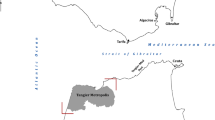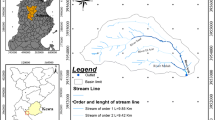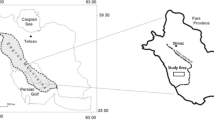Abstract
An erosion hazard map was elaborated using geomorphologic and lithological information; this was the base to characterize the erodibility of the territory. The aim of the proposed methodology is to define the areas where more detailed studies are necessary (e.g., to estimate rates of soil erosion, mitigation measurements, land use) to prevent future problems. Field work and remote sensing data (study of historical aerial photographs and satellite images) were used to understand the geomorphologic evolution and the current processes taking place in an area; this information was used to group the units according to its lithology, dynamic and slope inclination. The map was processed using the geographical information system and categorized in zones of very high, high, moderate, low and null fluvial erosion hazards. The map covers the Metropolitan Area of San Salvador, which is experiencing serious problems of mass wasting processes, collapse and settlements of foundations. Most affected areas belong to the Tierra Blanca Joven tephras which are unsaturated and cover most of the surface; nowadays, the urban projects and infrastructure resting in this material are suffering from extensive damage. The geotechnical information on the tephras shows a decrease in strength and collapsible behavior when saturated. Due to this, the use of Quickdraw tensiometers (suction) and TMS3 (soil moisture content) is proposed for monitoring. The methodology of erosion hazard mapping correlates well with mass wasting reported in the studied area, and for this reason, it could be a good way to protect the natural resources and improve the land use.
































Similar content being viewed by others
References
Avalos J, Castro R (2010) Caracterización geológica y geotécnica de la unidad “G” de Tierra Blanca Joven. Thesis, Universidad Centroamericana José Simeón Cañas
Behera P, Durga K, Das K (2005) Soil erosion modeling using MMF model. A remote sensing and GIS perspective. J Indian Soc Remote Sens 3(1):165–176
Bet H, DeRose R (1999) Digital elevation models as a tool for monitoring and measuring gully erosion. Int J Appl Earth Obs Geoinf 1(2):91–101
Bommer J, Salazar W, Samayoa R (1998) Riesgo sísmico en la región metropolitana de San Salvador. PRISMA. http://www.prisma.org.sv/uploads/media/riesgo.pdf. Accessed 23 January 2013
Bosse H, Lorenz W, Merino A, Mihm A, Rode K, Schmidt-Thomé M, Wiesemann G, Weber H (1978) Mapa geológico de El Salvador Escala 1:100 000. CNR, San Salvador
Bouziz M, Wijaya A, Gloaguen R (2011) Remote gully erosion mapping using ASTER Data and geomorphologic analysis in the main Ethiopian Rift. Geo-spatal Inf Sci 14(4):246–254
Charlton R (2007) Fundamentals of fluvial geomorphology. Routledge, London
Chavez J, Hernandez W, Kopecky L (2012a) Problemática y conocimiento actual de las tefras Tierra Blanca Joven en el Área Metropolitana de San Salvador, El Salvador. Rev Geol Amér Central 47:117–132
Chavez J, Valenta J, Schröfel J, Hernandez W, Šebesta J (2012b) Engineering geology mapping in the southern part of the metropolitan area of San Salvador. Rev Geol Amér Central 46:161–178
Chavez J, Šebesta J, Kopecky L, Lopez R, Landaverde J (2013) Unsaturated volcanic tephra and its effect for soil movement in El Salvador. Earth Sci. doi:10.11648/j.earth.20130202.15
Conforti M, Aucelli P, Robustelli G, Scarciglia F (2011) Geomorphology and GIS analysis for mapping gully erosion susceptibility in the Turbolo stream catchment (Northern Calabria, Italy). Nat Hazards 56:881–898
Gonzalez L, Romano L, Salamanca L (2004) Risk and disasters in El Salvador: economic, environmental, and social aspects. Geol Soc Am Spec Pap 375:461–470
Hernandez W (2004) Características geotécnicas y vulcanológicas de las tefras de Tierra Blanca Joven, de Ilopango, El Salvador. Thesis, Universidad Politécnica de El Salvador
Houston S, Houston W (1997) Collapsible soil engineering. In: Houston S, Fredlund D (eds) Unsaturated soil engineering practice. American Society of Civil Engineers, New York, pp 170–199
James L, Hodgson M, Ghoshal S, Latiolais M (2012) Geomorphic change detection using historic maps and DEM differencing: the temporal dimension of geospatial analysis. Geomorphology 137:181–198
Kim J, Saunders P, Finn J (2005) Rapid assessment of soil erosion in the Rio Lempa basin, Central America, using the Universal Soil Loss Equation and Geographic Information Systems (USLE). Environ Manage 36:872–885
Le Bissonnais Y, Montier C, Jamagne M, Daroussin J, King D (2001) Mapping erosion risk for cultivated soil in France. Catena 46(2):207–220
Lee S (2004) Soil erosion assessment and its verification using the universal soil loss equation and geographic information system: a case study at Boun, Korea. Environ Geol 45:457–465
Leh M, Bajwa S, Chaubey I (2011) Impact of land use change on erosion risk: an integrated remote sensing, geographic information system and modeling methodology. Land Degrad Dev. doi:10.1002/ldr.1137
Lexa J, Šebesta J, Chávez J, Hernandez W, Pécskay Z (2011) Geology and volcanic evolution in the southern part of the San Salvador Metropolitan Area. J Geosci 56:105–140
Lomnitz C, Schulz R (1966) The San Salvador earthquake of May 3, 1965. Bull Seismol Soc Am 56(2):561–575
Malik I (2008) Dating of small gully formation and establishing erosion rates in old gullies under forest by means of anatomical changes in exposed tree roots (Southern Poland). Geomorphology 93:421–436
Manyatsi A, Ntshangase N (2008) Mapping of soil erosion using remotely sensed data in Zombodze South, Swaziland. Phys Chem Earth 33:800–806
Martinez–Fernandez L, Martinez-Nuñez M (2011) An empirical approach to estimate soil erosion risk in Spain. Sci Total Environ 409:3114–3123
Molina B, Pérez G, Vásquez M (2009) Caracterización geotécnica de las tefras Tierra Blanca Joven: unidad “G” en la zona proximal y obras de protección. Thesis Universidad Centroamericana José Simeón Cañas
Ng C, Menzies B (2007) Advanced unsaturated soil mechanic and engineering. Taylor and Francis, United Kingdom
Nigel R, Rughoopth S (2010) Mapping of monthly soil erosion risk of mainland Mauritius and its aggregation with delineated basins. Geomorphology 114:101–114
Perroy R, Bookhagen B, Asner G, Chadwick O (2010) Comparison of gully erosion estimates using airborne and ground-based LIDAR on Santa Cruz Island, California. Geomorphology 118:288–300
Renscheler C, Harbor J (2002) Soil erosion assessment tools from point to regional scales-the role of geomorphologists in land management research and implementation. Geomorphology 47:189–209
Rolo R, Bomer J, Houghton B, Vallance J, Berdousis W, Mavrommati P, Murphy W (2004) Geologic and engineering characterization of Tierra Blanca pyroclastic ash deposits. Geol Soc Am Spec Pap 375:55–67
Romero E, Simms P (2008) Microstructure investigation in unsaturated soils: a review with special attention to contribution of mercury intrusion porosimetry and environmental scanning electron microscopy, indirect measurement of suction. Geotech Geol Eng 26(6):705–727
Toy T, Foster G, Renard K (2002) Soil erosion: processes, prediction, measurement, and control. Wiley, New York
Vrieling A (2006) Satellite remote sensing for water erosion assessment: a review. Catena 65:2–18
Vrieling A, de Jong S, Sterk G, Rodrigues S (2008) Timing of erosion and satellite data: a multi resolution approach to soil erosion risk mapping. Int J Appl Earth Obs Geoinf 10:267–281
Yang S, Zhu Q (2003) A model of intelligent interpreting soil erosion based on geographical knowledge. IGARSS ′03 Proceedings 4:2468–2470
Zhou W, Wu B, Zhang L, Li Q, Huang J, Li M (2004) Using remote sensing and GIS to estimate the probability of soil erosion rapidly. IGARSS ′04 Proceedings 5:3375–3378
Acknowledgments
The work had been funded in the framework of cooperation between the Czech Embassy in Costa Rica, Oficina de Planificación del Área Metropolitana de San Salvador (OPAMSS), Czech Geological Survey, Czech Technical University in Prague (ČVUT), Ministerio de Medio Ambiente y Recursos Naturales de El Salvador (MARN) and Universidad de El Salvador (UES). Authors acknowledge support of the Czech Geological Survey, Oficina de Planificación del Área Metropolitana de San Salvador (OPAMSS), Agronomy Faculty and Civil Engineer School of Universidad de El Salvador and the Geological Survey of the Ministerio de Medio Ambiente y Recursos Naturales de El Salvador (MARN). Special thanks go to Cecy, Andres and Daniel Chávez for assistance during this project. We are grateful to the reviewers and editors whose remarks improved the quality of the paper.
Author information
Authors and Affiliations
Corresponding author
Rights and permissions
About this article
Cite this article
Chávez Hernandez, J.A., Šebesta, J., Kopecky, L. et al. Application of geomorphologic knowledge for erosion hazard mapping. Nat Hazards 71, 1323–1354 (2014). https://doi.org/10.1007/s11069-013-0948-8
Received:
Accepted:
Published:
Issue Date:
DOI: https://doi.org/10.1007/s11069-013-0948-8




